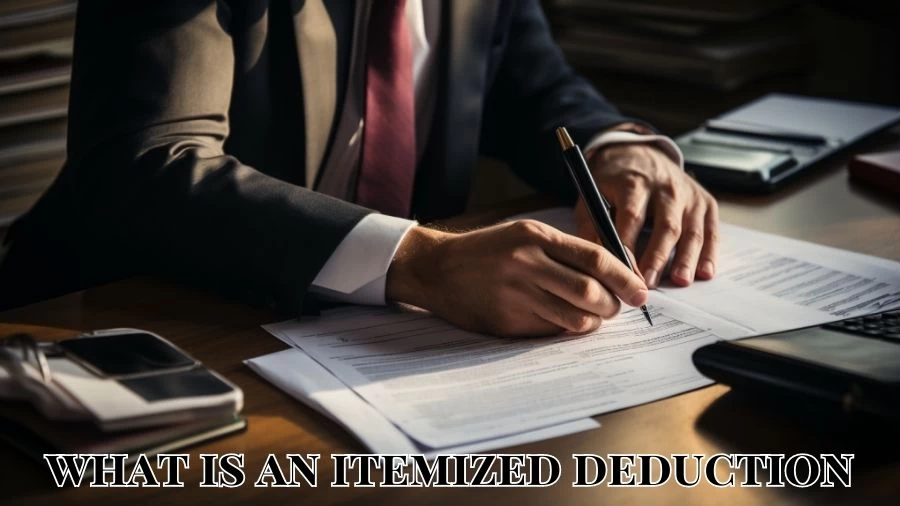
What is an Itemized Deduction? Who Should Itemize Deductions?
Itemized deductions enable eligible expenses to lower taxable income and minimize taxes, while taxpayers can alternatively opt for the standard deduction based on their filing status for simplicity or optimization.
by Kowsalya
Published Aug 28, 2023 | Updated Aug 28, 2023 | 📖 7 min read
What is an Itemized Deduction?
An itemized deduction constitutes an eligible expenditure that can be deducted from your adjusted gross income (AGI), resulting in a reduction of your taxable income and ultimately leading to a decrease in the total amount of taxes you are obligated to pay.
This deduction category encompasses various qualified expenses, including but not limited to mortgage interest, charitable contributions, and medical costs that haven't been reimbursed. Alternatively, taxpayers have the flexibility to opt for the standard deduction a predetermined fixed monetary value that varies depending on their specific filing status.
Should you choose to itemize deductions, you have the opportunity to subtract these eligible expenses from your AGI, which consequently helps in mitigating your overall tax liability. These deductions must be meticulously detailed and categorized on Schedule A of Form 1040—the official tax form used for reporting such deductions. This step ensures accurate and transparent documentation of your itemized deductions.
It's important to note that taxpayers possess the prerogative to either itemize their deductions, thereby providing comprehensive evidence of eligible expenses, or alternatively, they can claim the standard deduction that is applicable based on their individual filing circumstances. This decision hinges on optimizing tax benefits and minimizing the tax burden, offering individuals a strategic choice in managing their financial obligations.
What is an Itemized Deduction Example?
An itemized deduction is a specific category of expenses that taxpayers can declare on their tax returns in order to lower their taxable income. These deductions encompass various costs, including mortgage interest, state or local income taxes, property taxes, medical or dental expenses exceeding AGI limits, and charitable contributions .
Here are illustrative instances of itemized deductions:
- Mortgage Interest: If you possess a home and hold a mortgage, you have the option to deduct the interest paid on the mortgage as an itemized deduction .
- State and Local Taxes: You can claim a deduction for state and local income taxes or sales taxes as part of your itemized deductions .
- Charitable Donations: Donations made to qualified charitable organizations can be declared as itemized deductions, providing an opportunity to reduce your taxable income.
- Medical Expenses: Medical expenses that surpass 7.5% of your adjusted gross income (AGI) can be claimed as itemized deductions .
It's important to emphasize that taxpayers must make a decision between either opting for the standard deduction or itemizing their deductions. It's not permissible to utilize both approaches simultaneously.
How Are Itemized Deductions Calculated?
Itemized deductions are computed through the process of aggregating all qualifying expenses you accrued within the tax year and subsequently disclosing them on Schedule A of Form 1040.
Here's a breakdown of the steps to compute itemized deductions:
- Determine Eligibility: First, ascertain your eligibility to itemize deductions. This pertains to situations where the cumulative value of your itemized deductions surpasses the standard deduction amount relevant to your specific filing status .
- Gather Receipts and Records: Assemble all relevant receipts and records corresponding to the expenses you intend to assert as itemized deductions. These records should encompass evidence of charitable contributions, medical expenditures, mortgage interest, and payments for state and local taxes .
- Calculate Deductions: Compute the overall sum for each eligible expense you incurred over the tax year. Sum up these individual amounts to arrive at your total itemized deductions .
- Report Deductions: Proceed to document your comprehensive itemized deductions on Schedule A of Form 1040, facilitating accurate reporting and adherence to tax regulations.
When to Itemized Deduction?
If your qualified itemized deductions exceed your standard deduction, or if you're required to itemize due to ineligibility for the standard deduction, it's advisable to choose itemized deductions.
The standard deduction amount varies yearly and depends on factors such as income, age, filing status, and visual impairment . Certain circumstances prevent some individuals from utilizing the standard deduction, including married individuals filing separately if their spouse itemizes deductions, those filing a tax return for less than a year due to accounting period changes, nonresident or dual-status aliens, as well as estates, trusts, common trust funds, or partnerships.
Itemized deductions cover payments for state and local taxes (income or sales), real estate taxes, personal property taxes, mortgage interest, and losses from disasters. Also eligible are charitable contributions and a portion of medical and dental expenses . Note that specific limitations can apply to individual itemized deductions. Consult the Instructions for Schedule A (Form 1040) to discern the applicable restrictions.
What Can I Itemize on My Taxes?
The range of eligible expenses that can be itemized is comprehensive, as outlined on the official IRS website. This encompasses specific medical costs, mortgage interest, donations to charitable organizations, and state and local taxes. For accurate calculation and reporting, taxpayers utilize Schedule A, which is a component of IRS Form 1040.
In detail, the IRS Schedule A (Form 1040) can be accessed and downloaded from the IRS website. Noteworthy deductions include the ability to deduct mortgage interest on a loan valued at $750,000 or less for homes purchased on or after December 16, 2017. Charitable donations are also deductible, typically up to 60% of your Adjusted Gross Income (AGI), subject to certain criteria related to the type of contribution and the beneficiary organization.
Moreover, itemized deductions encompass qualified and unreimbursed medical and dental expenses that exceed 7.5% of your AGI. State and local income or sales taxes, in addition to real estate and personal property taxes, can be deducted up to $10,000 ($5,000 for those married filing separately). Other eligible deductions entail gambling losses and investment interest that is lower than investment income.
What Are the Pros and Cons of Pros and Cons of Itemizing Deductions?
Deductions You Can Itemize
- Mortgage interest on the first $750,000 of indebtedness—or $1 million, if you bought the home before Dec. 16, 2017
- Charitable contributions
- Medical and dental expenses over 7.5% of adjusted gross income (AGI)
- State and local income, plus either personal property or sales taxes up to IRS threshold
- Gambling losses
- Investment interest
Deductions You Cannot Itemize
- Mortgage interest on loan amounts over $750,000—unless you bought your home before Dec. 16, 2017
- State and local income, sales, and personal property taxes beyond IRS threshold
- Unreimbursed employee expenses
- Tax preparation expenses
- Natural disaster losses unless in a federally declared disaster area
What Does It Mean to Claim Itemized Deductions?
When you fill out your annual income tax return, you're presented with two choices: you can either choose the standard deduction, a set amount determined by your filing status, or you can decide to itemize your deductions.
Unlike the standard deduction, which is a fixed value applicable to all taxpayers, itemized deductions vary from individual to individual. These deductions hinge on the specific expenses outlined in Schedule A of Form 1040 that you are eligible to claim.
By adding up these deductions, you can then subtract the total from your taxable income, potentially resulting in a reduced tax obligation. This process offers the opportunity to tailor your deductions based on your unique financial situation and potentially optimize your tax outcome.
Who Should Itemize Deductions?
When preparing your tax return, one of the pivotal decisions you'll make is whether to claim the standard deduction or itemize your deductions. The standard deduction is a fixed amount that you can subtract from your taxable income, varying based on your filing status. On the other hand, itemizing involves listing out specific qualifying expenses, such as medical costs, mortgage interest, and charitable donations, and deducting their total value from your income.
Choosing between these two methods depends on the overall sum of your itemized deductions and how they compare to the standard deduction. If the total value of your eligible itemized deductions is higher than the standard deduction amount, it's usually in your best interest to go the itemizing route.
This allows you to capture a more accurate representation of your deductible expenses and potentially lower your taxable income, resulting in a reduced tax liability. However, if the sum of your itemized deductions is lower than the standard deduction, then opting for the standard deduction is typically the wiser choice.
What is an Itemized Deduction-
1. What is an itemized deduction?
An itemized deduction is a specific expense that taxpayers can subtract from their adjusted gross income (AGI) when calculating their taxable income.
2. What expenses can be itemized for deductions?
Various eligible expenses can be itemized for deductions, including mortgage interest, state and local taxes, charitable donations, medical and dental expenses that exceed a certain threshold, and certain miscellaneous expenses.
3. How does itemizing deductions work?
When you itemize deductions, you list and add up all qualified expenses you incurred during the tax year.
4. Can I choose between the standard deduction and itemizing deductions?
Yes, taxpayers can choose between taking the standard deduction or itemizing deductions.
5. Are there limitations to itemized deductions?
Yes, there are limitations on some itemized deductions.




